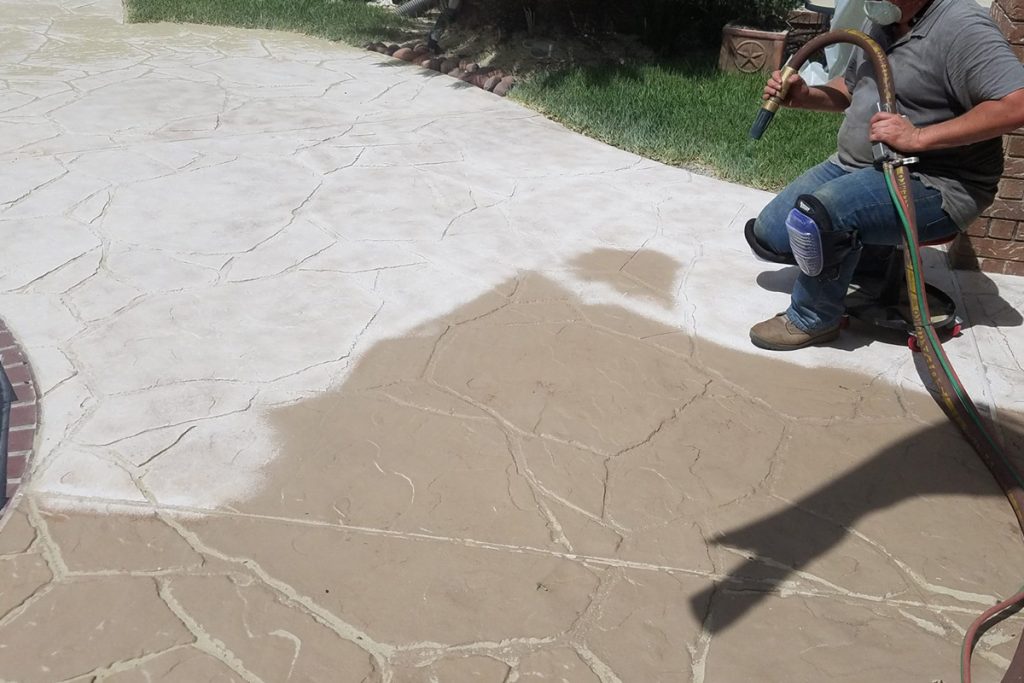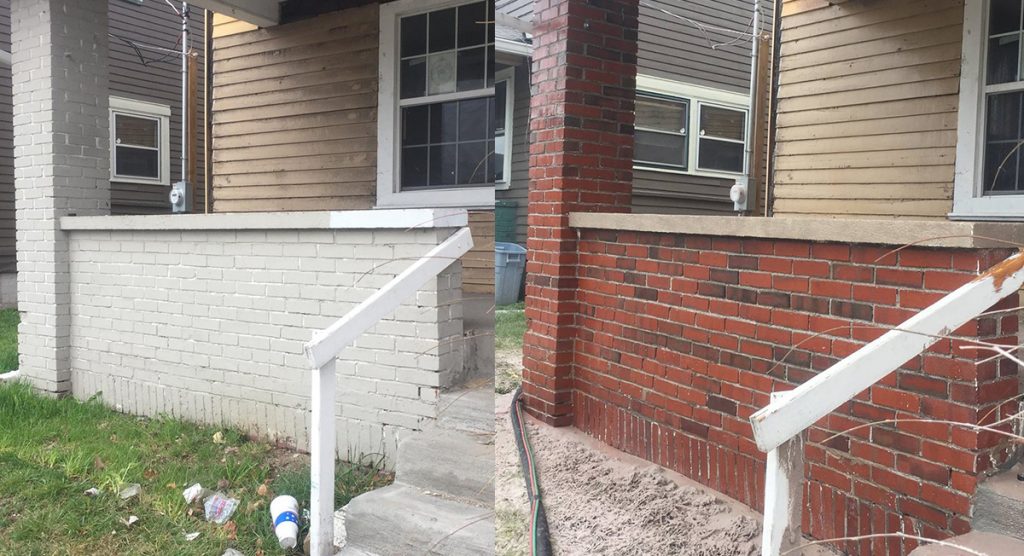Dallas – Fort Worth Concrete Cleaning

Over time, grime, dirt, and other oils can accumulate on concrete and other surfaces. Because these materials can be so porous, the dirt seeps deep down into the surface. You likely find yourself wondering how to remove stains from concrete.
In this guide, we’re here to provide you with everything you need to know about concrete and surface cleaning. No matter if you need to remove paint from concrete or wash clean an old set of bricks, you’ll learn everything you need to know here.
Remove Paint from Concrete
Removing paint from concrete can be quite time-consuming.
There are two primary ways to remove paint from concrete:
- using paint strippers
- dustless blasting the surface
If you’re going to use paint strippers, you need first to clean the concrete thoroughly and let it dry. This can take a couple of days because concrete is so porous. You may think that it’s dry when this is not the case in reality.
After cleaning the surface, you need to scrape or peel any paint that’s cracked or chipping. Then, when you’ve removed as much paint as possible, you can apply the paint stripper. You’ll need to follow instructions and wait as long as recommended. Then, you can remove the paint stripper residue and repeat the cycle as many times as necessary.
As you can imagine, this is a painstaking process. Because concrete is porous, paint has likely seeped well below the surface. If you’re looking to return concrete to its original color, you’re going to need to apply paint strippers a couple of times.
The other option you have is dustless blasting.
Dustless blasting involves mixing abrasives with water to help clean surfaces. Dustless blasting is known to strip paint and remove graffiti. Dustless blasting removes paint more efficiently than chemical strippers. You don’t have to worry about breathing in toxins during the process since dustless blasting is entirely safe.
Additionally, dustless blasting takes up far less time than the manual process with chemicals. When using chemicals, you need to allow everything to dry before applying other coats of the paint stripper. This is not the case with dustless blasting, which removes a good majority of the paint on the first pass.
Because it has abrasives, it can get deep into porous surfaces, providing you with a deep clean.
Power Washing versus Dustless Blasting Concrete
If you need to clean concrete, one of the decisions you need to make is power washing v. dustless blasting. The two techniques are somewhat similar in that they rely on high-pressured water to clean surfaces.
However, that’s about where the similarities end.
Dustless blasting adds abrasives to the water, which prove to be much more effective when cleaning.
The added abrasives can help penetrate deep-to-reach surfaces. So, when cleaning porous surfaces like concrete or brick, you’ll find that dustless blasting is the far more useful option. Neither option will harm your surface, and the only mess you’ll have to worry about with either is runoff from the water.
If you’re looking for a deep-penetrating cleaning option, a power washer just isn’t going to cut it.
You need the extra-strength cleaning power of an abrasive to help remove tough stains. For that reason, dustless blasting takes the cake as the go-to when comparing power washing versus dustless blasting concrete.
Sandblasting versus Dustless Blasting Concrete
The other option you have is sandblasting v. dustless blasting concrete. While the decision between power washing and dustless blasting is somewhat close, choosing between sandblasting and dustless blasting isn’t very close at all.
As the name indicates, sandblasting relies on the sand to clean surfaces. Sandblasting is highly abrasive, strong enough to remove rust from metal. During the sandblasting process, there is enough friction to heat the metal to the point where it warps. So while it may clean your concrete or brick surfaces, it could also cause long-lasting problems that you can’t repair.
Dustless blasting, on the other hand, is just a powerful a cleaner while also significantly gentler. Dustless blasting relies on abrasives to clean concrete.
However, it also mixes the abrasive with water. Essentially, it’s a hybrid between power washing and sandblasting. Dustless blasting takes the primary benefits of both and combines them into one solution that’s easy to use.
Sandblasting may be a bit cheaper than dustless blasting, but you might cause long-term problems to your surface. The cost of having to replace concrete isn’t nearly as much as the cost of upgrading to dustless blasting. If you’re serious about preserving the life of your surface, the sandblasting v. dustless blasting decision is a no-brainer.
Dustless blasting is the clear winner.
Brick Cleaning

One of the other surfaces you may need to clean is brick. There are a few options available to do so.
First and foremost, you could use the old-fashioned method, scrubbing the brick by hand. If you’re going to do this, you need to mix equal parts vinegar and water into a spray bottle. Spray the mixture onto the brick and allow it to sit for a few minutes. Then, use a nylon-bristled brush to scrub the dirt and grime away from the brick.
While this method can be useful, it’s painstaking and time-consuming.
Another technique that you have is sandblasting. Sandblasting cleaning involves the use of very fine sand, like the kind you would see in playground boxes. You’ll then spray the brick surface with the sand, which acts as an abrasive to remove paint or other buildups.
However, sandblasting brick walls is not without consequences, especially if your surface is very old. Sandblasting walls that are old can cause things such as:
- Spalling
- Sub-Efflorescence
- Cosmetic Damage
Although the sandblasting will remove paint and dirt, it will also get rid of the outer protective layer on the brick.
When spalling occurs, the brick “eats itself” and self-destructs. The brick will slowly turn into a powder and begin to fall apart. Spalling is one of the most likely results of sandblasting brick.
Sub-efflorescence occurs when moisture builds up inside the brick, causing the mortar to fail and the brick to fall to the ground. Sandblasting in and of itself doesn’t cause this.
However, many people tend to put a sealant on after sandblasting to prevent spalling. Unfortunately, they don’t realize that in doing so, they’re taking away from the natural properties of the brick.
Brick tends to be quite porous, allowing water and air to pass through. When you put a sealant on, you’re taking away from its natural properties, which is was causes sub-efflorescence.
The last thing that can occur during sandblasting is cosmetic damage. The appearance of your antique, rustic brick is forever ruined, and there’s nothing that you can do to bring it back. The tuckpointing or mortar joints that may have given your brick character in the past are forever ruined, having been blasted away with the face of the brick.
The appearance will appear rough and won’t be as attractive as the original brick.
The last option you have to clean brick is dustless blasting. Although dustless blasting uses abrasives, it mixes them with water. This allows it to be just as effective as sandblasting without the added consequences.
By choosing dustless blasting as your brick cleaning option, you’re committing to preserving the life and structural integrity of your bricks.
Clean Your Surfaces Today
If you need to remove stains from concrete, you may find yourself overwhelmed by the options available. Many people think that the right method depends on what type of surface you’re cleaning.
However, this is not the case.
No matter if you’re cleaning brick, concrete, or any other type of surface, you’ll want to go with dustless blasting.
Dustless blasting is strong enough to remove tough stains from any porous surface. But, because it mixes water with abrasives, it has a much stronger impact. Dustless blasting tends to be more effective than power washing, but it doesn’t destroy surfaces like sandblasting.
Dustless blasting may be a bit more expensive than sandblasting, power washing, or manual efforts, but it’s an investment well worth making.
For one, you can trust that your surface will remain intact and that you won’t cause any long-term structural damage. The cost of dustless blasting pales in comparison to the cost of having to replace an entire surface.
Dustless blasting also does not cause much of a mess. The only thing you’ll have to worry about is a bit of water runoff. If using paint thinners or vinegar, you’ll need to worry about toxic runoff that can damage your lawn or garden. If you sandblast, you’ll have stubborn dust and sand everywhere that’s difficult to get rid of. But not so is the case with dustless blasting, which relies on water to clean messes.
So, what are you waiting for?
If you’ve been longing to clean a concrete or brick surface at your home or office, contact Willsha Blasting today to learn more about our dustless blasting offerings.
Willsha Blasting offers our services throughout the Dallas – Fort Worth metroplex.
